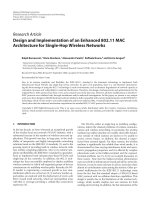Lecture 7 - 802.11 WLAN Architecture
Bạn đang xem bản rút gọn của tài liệu. Xem và tải ngay bản đầy đủ của tài liệu tại đây (543.39 KB, 38 trang )
February 2005 Copyright 2005 All Righs Reserved 1
802.11 Network Architecture
(1 September, 2006)
February 2005 Copyright 2005 All Righs Reserved 2
●
Define the different types of service sets that
can be configured
●
Explain what beacons are and what
information they provide
●
Describe authentication and association and
how they allow users to gain access to the
wireless LAN
●
Define the power management features
available with wireless LANs
●
Explain Dynamic Rate Shifting
Objectives
Upon completion of this lecture you will be able to:
February 2005 Copyright 2005 All Righs Reserved 3
802.11
WLAN Topology
and
Architecture
February 2005 Copyright 2005 All Righs Reserved 4
●
Distribution System (DS).
✔
A wired/wireless medium which connect the Access Points to one
another.
✔
The backbone network used to relay frames between access points
●
Access Points (AP).
✔
APs form a bridge between wired and wireless medium.
✔
Coordinate the connection of wireless stations to the DS
●
Wireless Medium.
✔
The Radio Frequency spectrum used to transfer frames between the
wireless station and the AP or between wireless stations.
●
Wireless Stations.
✔
Computing devices with wireless network interfaces.
✔
Typically battery operated laptops or handheld computers.
Major WLAN Components
February 2005 Copyright 2005 All Righs Reserved 5
●
Independent Basic Service Set (IBSS).
✔
No Access Point
✔
An ad-hoc group of wireless nodes.
✔
Peer-to-peer transmission
✔
One node is elected to act as a proxy to perform the
functions of the AP.
WLAN Types
February 2005 Copyright 2005 All Righs Reserved 6
WLAN Types Contd
Access Point
Network
W
i
r
e
l
i
n
e
N
e
t
w
o
r
k
●
Basic Service Set (BSS).
✔
A single Access Point
✔
The AP acts as a bridge between clients and the wireline.
✔
Roaming is limited to the single radio cell
✔
All clients operate on the same channel.
✔
A BSS connected to a wired network is called an Infrastructure BSS.
✔
The clients must request to join and be accepted to associate with the AP
before they can send data.
✔
A BSS is identified by a 48 bit hex value called the BSS identifier – BSSID.
This is the MAC address of the AP
February 2005 Copyright 2005 All Righs Reserved 7
●
Extended Service Set (ESS).
✔
Multiple Access Points that communicate through the DS.
✔
The APs share the same Service Set Identifier (SSID) – an Extended SSID
or ESSID.
✔
The AP acts as a bridge between clients and the wireline.
✔
Each AP forms a radio cell that overlap. Each AP is assigned a different
channel
✔
All clients operate on the same channel in the same cell but can communicate
through the DS.
✔
The APs interconnected through the Wireline constitute a Distributed
System.
Access Point
Access Point
Wireline Network
WLAN Types Contd
February 2005 Copyright 2005 All Righs Reserved 8
●
Extended Service Set (ESS) Contd.
✔
The SSID is used to control APs with which the stations can associate.
✔
Clients may also associate with an AP using a special "null" SSID value
which indicates they would like to associate with any AP within range
regardless of the assigned APs SSID.
✔
AP can be configured to reject this "null" value.
✔
The BSSID identifies a single BS.
✔
The ESSID denotes a group of APs sharing a common SSID within which a
client can roam.
Access Point
Access Point
Wireline Network
WLAN Types Contd
February 2005 Copyright 2005 All Righs Reserved 9
●
Station Services
✔
Authentication - The client identifies itself to the
AP in order to form an Association. This can be done
by:
☛
Service Set Identifier (SSID)
☛
MAC Filtering.
✔
De-authentication - Destroys a previously known
station identity- terminates the current Association.
☛
The device shuts down.
☛
Out of AP range
802.11 Network Services
February 2005 Copyright 2005 All Righs Reserved 10
●
Distribution Services.
✔
Association - establish a logical connection between the
client and the AP, i.e., A station registers with an AP.
☛
Determines the location of the client for the DS.
☛
Determines the path to reach the DS needs to reach the client.
☛
A client can be authenticated to multiple APs but Associated
with only one AP.
✔
Reassociation - Retains network session information when
the wireless client passes from one AP to another AP.
☛
This information tells the new AP the identify of the last AP.
☛
This allows the old AP to forward any remaining frames to the
new AP for delivery via the DS.
802.11 Architecture Contd
February 2005 Copyright 2005 All Righs Reserved 11
●
Distribution Services contd.
✔
Disassociation - Tear down the association between the AP
and the wireless device.
☛
The device leaves the AP area.
☛
The AP is shutting down.
✔
Distribution - Determines the location to which the frame
should be forwarded by the AP - An AP uses the DS to deliver
frames.
☛
Another AP.
☛
A Wireless client.
☛
The Wired Network.
✔
Integration - Provides a MAC framing service to the AP.
☛
Translates the 802.11 format to the Wired LAN format.
☛
Translates the Wired LAN format to the 802.11 format.
802.11 Architecture Contd
February 2005 Copyright 2005 All Righs Reserved 12
●
Fragmentation.
✔
Spatial Density results in interference which requires data retransmission.
✔
802.11 can be configured to send smaller packets.
●
Power Management.
✔
Mobile clients can enter the sleep mode to conserve power but still
remain connected.
☛
A 20 byte Power Save Poll (PS-Poll) is sent to the AP.
☛
The AP buffers all packets destined for he device until it comes back on
line.
●
Multicell Roaming.
✔
Roaming is based upon determining the S/N ratio.
✔
AP sends out beacon messages containing link measurement data
✔
The client listens and determines which AP has the stronger signal
802.11 - Other Operations
February 2005 Copyright 2005 All Righs Reserved 13
Locating a WLAN
February 2005 Copyright 2005 All Righs Reserved 14
Locating a WLAN
●
The wireless client locates the Access
Point by scanning the airways for its RF
signal.
●
It locates the AP by identifying its Service
Set Identifier (SSID) through:
✔
Passive Scanning
✔
Active Scanning
✔
Beacons
February 2005 Copyright 2005 All Righs Reserved 15
Service Set Identifier (SSID)
●
The SSID is used by WLAN as a network name.
✔
Unique
✔
Case sensitive
✔
Alphanumeric value
✔
2-32 characters
●
The SSID is used for
✔
Segmenting networks
✔
Rudimentary security measure
✔
Joining a network.
●
The SSID is used in:
✔
Beacons
✔
Probe Requests
✔
Probe Responses, etc.









